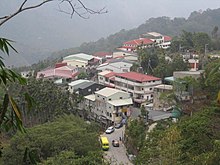|
Village (Taiwan)
Villages are the basic level administrative subdivisions of the Republic of China, under townships, county-administered cities or districts. There are two types of villages depending on the divisions it belongs to.[1]
Structuring and sizingThe history of villages in Taiwan could date back to the Hoko system in the Japanese era, which ho (保) changed into village after the Republic of China ruled Taiwan. The formation of a village helps divide areas into considerations for transportation and city planning. The formation of the village and its size depend largely on the county it is located in or the population nature of the local area. In counties or districts with a limited population, 100 households could form a village, whereas in densely populated New Taipei, 1,000 households are necessary to form a village. In very densely populated areas, a village could comprise a population of up to 4,000 households. Thus, the size of villages varies widely. The following are the statistics of villages in each administrative division in June 2018.
Head The head of a village is elected by the people of the village every four years, the head is subsidized with NT$45,000 per month for local transportation, stationary, postage and bill fees. The head of a village holds responsibility to initiate and hold meetings, handout certificates of various sorts, encourage bill payments and assist filling out of government documents if required. See also
Notes
References
|
|||||||||||||||||||||||||||||||||||||||||||||||||||||||||||||||||||||||||||||||||||||||||||||||||||||||||||||||||||||||||||||||||||||||||||||||||||||||||||||||